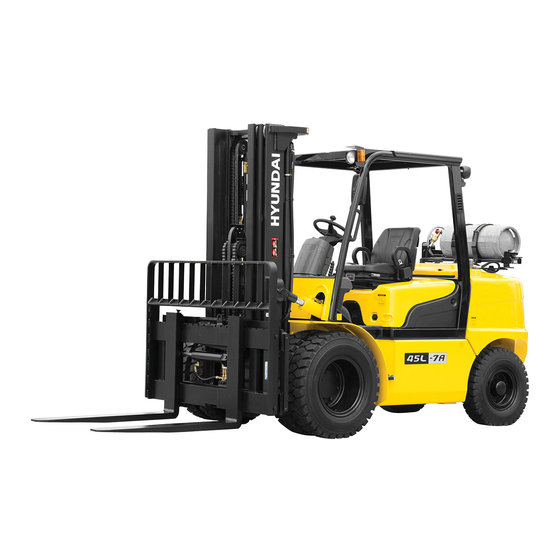
Advertisement
Quick Links
FOREWORD
1. STRUCTURE
This service manual has been prepared as an aid to improve the quality of repairs by giving the
serviceman an accurate understanding of the product and by showing him the correct way to perform
repairs and make judgements. Make sure you understand the contents of this manual and use it to
full effect at every opportunity.
This service manual mainly contains the necessary technical information for operations performed in
a service workshop.
For ease of understanding, the manual is divided into the following sections.
SECTION 1 GENERAL
This section gives the general information of the machine and explains the safety hints for
maintenance.
SECTION 2 REMOVAL & INSTALLATION OF UNIT
This section explains the procedures and techniques of removal and installation of each component.
SECTION 3 POWER TRAIN SYSTEM
This section explains the structure of the transmission as well as control valve and drive axle.
SECTION 4 BRAKE SYSTEM
This section explains the brake piping, each component and operation.
SECTION 5 STEERING SYSTEM
This section explains the structure of the steering unit, priority valve, trail axle as well as steering
circuit and operation.
SECTION 6 HYDRAULIC SYSTEM
This section explains the structure of the gear pump, main control valve as well as work equipment
circuit, each component and operation.
SECTION 7 ELECTRICAL SYSTEM
This section explains the electrical circuit and each component.
It serves not only to give an understanding electrical system, but also serves as reference material for
troubleshooting.
SECTION 8 MAST
This section explains the structure of mast, carriage, backrest and forks.
The specifications contained in this service manual are subject to change at any time and without any
advance notice. Contact your HYUNDAI distributor for the latest information.
0-1
Advertisement

Summarization of Contents
SECTION 1 GENERAL
Group 1 Safety hints
Provides essential safety guidelines and precautions for performing maintenance and operations.
Group 2 Specifications
Details major components of the forklift, listing their names and corresponding numbers.
Group 3 Periodic replacement
Outlines a schedule for replacing consumable parts to ensure operational safety and longevity.
GROUP 2 SPECIFICATIONS
1. MAJOR COMPONENTS
Identifies and illustrates key components of the forklift with numerical labels.
3. SPECIFICATION FOR MAJOR COMPONENTS
1) ENGINE
Lists detailed specifications for the engine, including model, type, and performance metrics.
(2) MAIN PUMP
Provides specifications for the main hydraulic pump, covering type, capacity, and pressure ratings.
(3) MAIN CONTROL VALVE
Details specifications for the main control valve, including type, operation, and pressure ratings.
SECTION 2 REMOVAL & INSTALLATION OF UNIT
Group 1 Structure
Illustrates the structural components of the mast with a numbered diagram and list.
Group 2 Removal and installation of unit
Details the procedures for removing and installing the power train components.
SECTION 3 POWER TRAIN SYSTEM
Group 1 Structure and operation
Explains the overview and operational principles of the power train system's components.
Group 2 Inspection and troubleshooting
Provides methods for inspecting the transmission and troubleshooting common operational issues.
Group 3 Disassembly and assembly
Details the step-by-step procedures for disassembling and assembling drive axle components.
SECTION 4 BRAKE SYSTEM
Group 1 Structure and function
Describes the two brake systems (foot and parking) and their basic operational principles.
Group 2 Operational checks and troubleshooting
Guides on performing operational checks and troubleshooting common brake system problems.
Group 3 Tests and adjustments
Provides procedures for brake system testing and adjustments, including air bleeding.
SECTION 5 STEERING SYSTEM
Group 1 Structure and function
Explains the composition and operational principles of the steering system.
Group 2 Operational checks and troubleshooting
Covers checks and troubleshooting for steering system operation and common issues.
Group 3 Disassembly and assembly
Details the procedures for disassembling and assembling the steering unit.
SECTION 6 HYDRAULIC SYSTEM
Group 1 Structure and function
Presents the hydraulic circuit diagram and explains the system's functional principles.
Group 2 Operational checks and troubleshooting
Outlines operational checks and troubleshooting for hydraulic system performance issues.
Group 3 Disassembly and assembly
Provides detailed steps for disassembling and assembling the main hydraulic pump.
SECTION 7 ELECTRICAL SYSTEM
Group 1 Component location
Illustrates the locations of various electrical components on the forklift.
Group 2 Electrical circuit
Shows the overall electrical circuit diagram, detailing connections between components.
Group 3 Component specification
Lists specifications for individual electrical components, including voltage and wattage.
Group 4 Connector destination
Maps connector numbers to their destinations and part numbers for electrical harness.
Group 5 Troubleshooting
Offers solutions for common electrical system problems based on symptoms.
SECTION 8 MAST
Group 1 Structure
Illustrates the structural components of the 2-stage mast (V mast) with labels.
Group 2 Operational Checks and Troubleshooting
Covers operational checks and troubleshooting for the mast and forks.
Group 3 Adjustment
Provides procedures for adjusting mast load rollers and back-up liners for proper operation.
Group 4 Removal and Installation
Details the steps for removing and installing forks, backrest, and carriage components.













Need help?
Do you have a question about the 40L-7A and is the answer not in the manual?
Questions and answers